


























Babu Ghat Kolkata, 1971
Braying horse, 1972
Childhood friend, 1969
Classroom, 1972
Deaf and dumb friend, 1971
Deep conversation, 1972
Drinking water, 1972
Enjoying market waste, 1972
Galloping horse, 1972
Goats strolling, 1973
Grazing goats, 1973
Group of horses, 1973
Horse in motion, 1972
Horse rear view, 1973
Horse side view, 1972
Horses interacting, 1972
Kulu Valley, 1972
Light on palette, 1973
Lonely goat, 1973
Madhu, 1973
Naughty boy, 1973
Pahelgaon, 1972
Portrait of Satish, 1972
Slum character, 1973
Snowy mountain, 1972
Twilight, 1972
Waiting, 1972


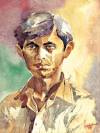

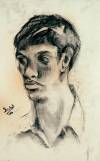

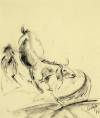


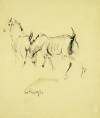


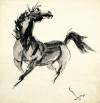




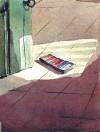
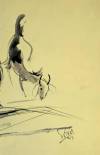
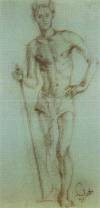




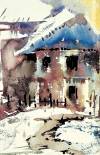
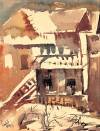
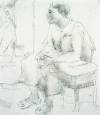
1969 - 73 Academic period Kolkata
Sen’s draftsmanship skill in Kolkata before leaving for Paris: His basic learning of fine arts with technicalities started at Indian College of Art from 1969 – 70 and Government College of Arts & Crafts from 1971 – 73.
Sen started drawing and modelling from an early age inspired by the artisans and craftsmen in his Shohid Nagar squatted refugee colony who for their livelihood would make idols, clay pots, clay dolls, shell bangles and sachets. Another great influence in Sen’s childhood was his mentor he addressed as Subhinoy Uncle, a graduate artist from Indian Art College, Kolkata. Subhinoy taught him the rudiments of art, but always discouraged Sen from pursuing this subject, saying that he tried very hard to make a career with art, but it was impossible, so he had to settle for a clerical job in Electricity Supply. So according to Subhinoy, studying art had no future. However, for Sen, Subhinoy was a role model who taught him to become proficient in art. Sen painted “Portrait of a childhood friend” (seen above) in water colour in 1969, just before he entered art college.
In his Kolkata art college days, Sen had to deal with the two contrasting faces of Kolkata: Victorian Kolkata with its imposing buildings like his art college, Victoria Memorial, St Paul’s Cathedral and the High Court, and Bengali Kolkata with its crowded streets and over-crowded trains that Sen could connect to, although this too was dissimilar to his poverty stricken refugee colony of non-permanent mud homes with no electricity.
Sketching people: While practicing his drawing assignments, Sen would sit for hours every day at the railway station, at street corners or the river bank sketching people at different moments of life as it happens. This strengthened his drawing skills as a draftsman.
Influence from Leonardo’s horses: Sen has always admired the beauty and strength of horses and their character of loyalty and elegance. He was inspired by Leonardo da Vinci’s drawings of horses. He learnt how to draw horses at the Kolkata Mounted Police stables. He had negotiated hard with the stable boys there to allow him to come regularly, observe and study the horses in their various actions, and sketch them. Sen sometimes even lived overnight at the horse stable.
Artistic search for textured paper, economic find in waste paper: Sen has always been fascinated to do drawing with charcoal on different types of textured paper. In one of his regular trips through the innards of Kolkata, he discovered a manual book binding place in Boitok Khana Bazar that used different types of paper. He was thrilled with this “treasure-house” of uneven textured paper he’s always been in search of. He couldn’t afford to buy the different types of paper here, but the binders, infected by his enthusiasm, would keep aside sheets of paper that were a little torn or damaged to give to Sen free of cost. Later in his initials days in France, Sen sold lots of this work to earn his livelihood.
Sen started drawing and modelling from an early age inspired by the artisans and craftsmen in his Shohid Nagar squatted refugee colony who for their livelihood would make idols, clay pots, clay dolls, shell bangles and sachets. Another great influence in Sen’s childhood was his mentor he addressed as Subhinoy Uncle, a graduate artist from Indian Art College, Kolkata. Subhinoy taught him the rudiments of art, but always discouraged Sen from pursuing this subject, saying that he tried very hard to make a career with art, but it was impossible, so he had to settle for a clerical job in Electricity Supply. So according to Subhinoy, studying art had no future. However, for Sen, Subhinoy was a role model who taught him to become proficient in art. Sen painted “Portrait of a childhood friend” (seen above) in water colour in 1969, just before he entered art college.
In his Kolkata art college days, Sen had to deal with the two contrasting faces of Kolkata: Victorian Kolkata with its imposing buildings like his art college, Victoria Memorial, St Paul’s Cathedral and the High Court, and Bengali Kolkata with its crowded streets and over-crowded trains that Sen could connect to, although this too was dissimilar to his poverty stricken refugee colony of non-permanent mud homes with no electricity.
Sketching people: While practicing his drawing assignments, Sen would sit for hours every day at the railway station, at street corners or the river bank sketching people at different moments of life as it happens. This strengthened his drawing skills as a draftsman.
Influence from Leonardo’s horses: Sen has always admired the beauty and strength of horses and their character of loyalty and elegance. He was inspired by Leonardo da Vinci’s drawings of horses. He learnt how to draw horses at the Kolkata Mounted Police stables. He had negotiated hard with the stable boys there to allow him to come regularly, observe and study the horses in their various actions, and sketch them. Sen sometimes even lived overnight at the horse stable.
Artistic search for textured paper, economic find in waste paper: Sen has always been fascinated to do drawing with charcoal on different types of textured paper. In one of his regular trips through the innards of Kolkata, he discovered a manual book binding place in Boitok Khana Bazar that used different types of paper. He was thrilled with this “treasure-house” of uneven textured paper he’s always been in search of. He couldn’t afford to buy the different types of paper here, but the binders, infected by his enthusiasm, would keep aside sheets of paper that were a little torn or damaged to give to Sen free of cost. Later in his initials days in France, Sen sold lots of this work to earn his livelihood.


